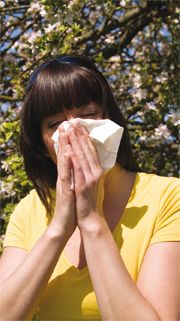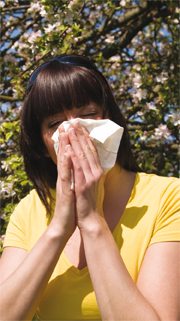Ahhh-choo! Keeping Home Allergens at Bay

 Summer is not the best season for allergy sufferers. Allergens are everywhere; there is no escaping the congestion, sneezing and itchy eyes that plague allergy sufferers. Outside allergens lurk in the mulch, leaf piles, gutters, and anywhere that pollen and mold spores can be found, forcing allergy sufferers indoors. Unfortunately there is a whole different source of allergens inside. Dust, mold, mildew, dander and mites inhabit the furniture, knick-knacks, draperies, bedding, carpeting, pets and what seems like every spot in between, just waiting to wreak havoc.
Summer is not the best season for allergy sufferers. Allergens are everywhere; there is no escaping the congestion, sneezing and itchy eyes that plague allergy sufferers. Outside allergens lurk in the mulch, leaf piles, gutters, and anywhere that pollen and mold spores can be found, forcing allergy sufferers indoors. Unfortunately there is a whole different source of allergens inside. Dust, mold, mildew, dander and mites inhabit the furniture, knick-knacks, draperies, bedding, carpeting, pets and what seems like every spot in between, just waiting to wreak havoc.
Although avoiding allergens seems next to impossible, it is not necessary to strip your house of everything that you love to create an allergy-free area. Allergy sufferers can improve the quality of their lives by understanding how allergens function and focusing on basic allergen control.
According to allergy specialist Dr. Charles Lane, “Over the past 30 years, the number of people suffering with allergies is definitely on the rise.” Viral infections, as well as exposure to certain chemicals and indoor and outdoor pollutants all contribute to developing allergic responses. Understanding the causes of an allergic response is the first step to controlling allergies.
Outside allergens include tree, grass and weed pollens, and molds. Quinn Mongan of SERVPRO points out that any time decaying matter is present, mold will develop. All mold needs to thrive is a food source and moisture. So be sure to clean out gutters where leaves collect and decay, and rid the garden of plant debris that creates mold spores. Consider using stones as mulch instead of tree bark.
 Dust mites, mold, mildew and animal dander are the major indoor culprits. Since about one-third of a person’s day is spent in the bedroom, concentrate on cleaning that room first. Bedding should be washed once a week in hot water above 130 degrees to kill dust mites (cold water is ineffective). Place stuffed toys in plastic zip-lock bags and leave in the freezer overnight; this will kill the offending mites without destroying the integrity of the toy.
Dust mites, mold, mildew and animal dander are the major indoor culprits. Since about one-third of a person’s day is spent in the bedroom, concentrate on cleaning that room first. Bedding should be washed once a week in hot water above 130 degrees to kill dust mites (cold water is ineffective). Place stuffed toys in plastic zip-lock bags and leave in the freezer overnight; this will kill the offending mites without destroying the integrity of the toy.
Matt Fiery of Oreck Clean Home stresses the importance of pillow and mattress encasement in the fight against home allergens. The amount of dust mite debris that collects in bedding is astronomical. According to Fiery, “The average mattress doubles in weight after ten years from the collection of dust mites.” Fiery says dust mites also thrive in carpets, draperies and upholstered furniture.
If you clean regularly, it is possible to rid the house of much of the dust and mold that causes allergic responses. Vacuum carpets, upholstered furniture, draperies and other areas that cannot be washed. Make sure that your vacuum has a HEPA (high efficiency particulate air) filter. Fiery recommends vacuuming as opposed to rug shampooing, unless rugs can be dried quickly and completely. Keep things simple. Avoid open shelving and clutter. Store as much as possible in drawers and closets, and keep closet doors closed.
For those allergic to cat and dog dander, minimize the allergic person’s contact with the pet and keep it out of that person’s bedroom. After children play with a pet, have them change their clothes. Just being near clothing concentrated with dander can cause an allergic response, not only to the one wearing the clothes but to anyone coming into contact with that person.
 Beyond Routine Housecleaning
Beyond Routine Housecleaning
It is important to keep tabs on the humidity level in your home; it should be maintained between 45 and 50 percent. Dust mites need moisture to survive, and the installation of a dehumidifier can work wonders to curtail infestation. Install a centralized system, or at least a room dehumidifier in the bedroom.
Consider installing a centralized air cleaner or an individual room air cleaner. Jerry Gilmore of Aqua Clear suggests a whole-house HEPA model to capture dander, bacteria and pollen, and to deliver clean air throughout the house. Dr. Lane provides a word of caution when using electrostatic filters that produce ozone, however; ozone can affect asthma sufferers.
Roger Jones of W.C. Butler Heating & Air Conditioning stresses the importance of air filters. “They probably have more to do with taking allergens out of the air than anything,” says Jones. There are many filter choices, ranging in price from a few dollars to over $1,000. The more expensive models that use ultraviolet light remove not only smoke and pollen from the air, but also viruses and germs.
Another key element in allergen control is the heating and cooling system itself—particularly the ductwork. It can develop leaks, and can draw air from non-desirous places like the attic, crawl space and walls. Damp air combines with dust and dirt, resulting in mold; this unfiltered air goes through the ducts and into the living space. So it’s important to have ductwork checked. Clean if necessary, and seal all leaks. Make sure that the air filtration system is in good working order, and service the heating and cooling units on a schedule.
Allergy control begins at home. Focus on the basics. You can maintain quality indoor air with these measures: routine cleaning, adequate filtration systems, ensuring that your heating and cooling system is working properly, and controlling household humidity. With these simple steps, allergy sufferers can work to avoid the sneezing and wheezing that comes with every season.






